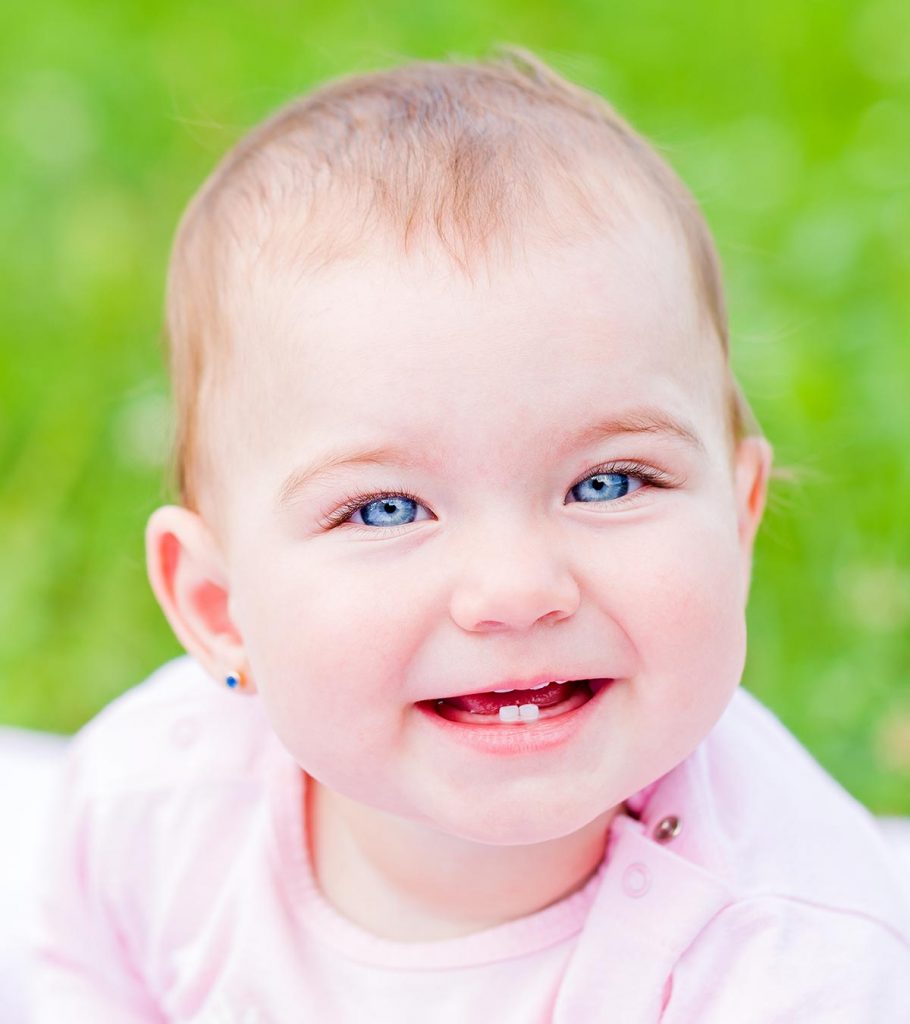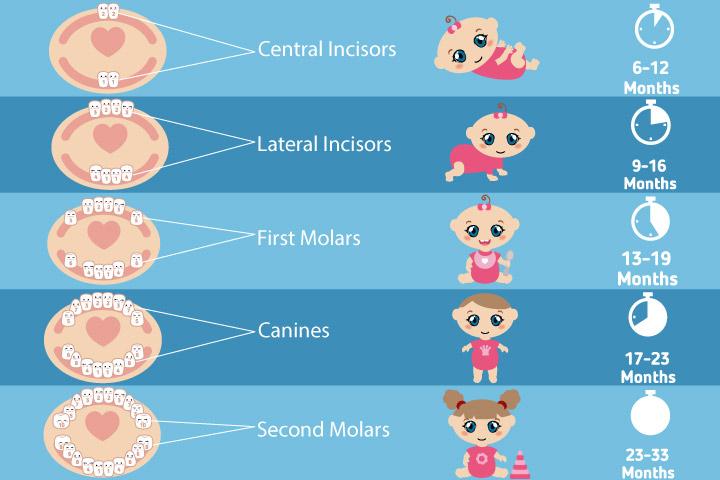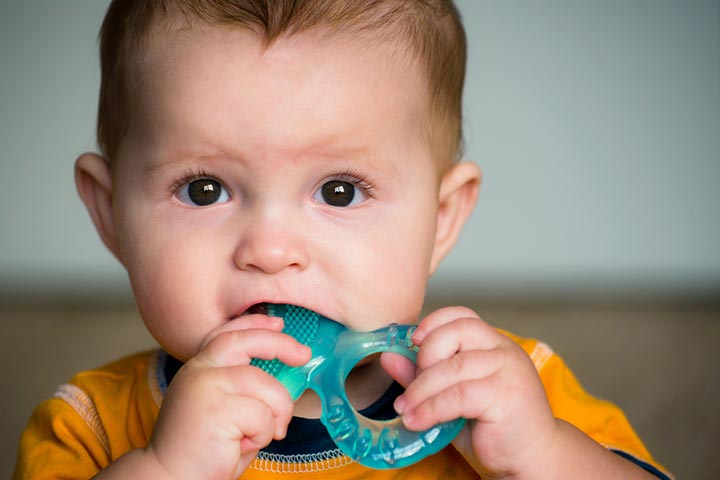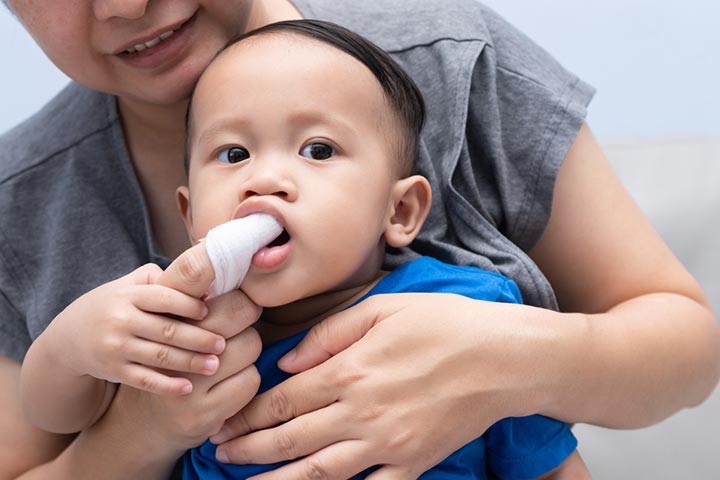Teething in babies occurs when the baby’s first tooth comes out through the gums. Although it adds to their cuteness and makes us adore them even more, it may not be as enjoyable for the baby. Parents constantly worry about when their baby will get their first tooth, especially the pain and fussiness it mostly brings along. However, there are certain signs that indicate the start of teething. Knowledge about them may help you prepare in advance for the process. In this post, we will tell you about teething, its signs, ways to help your baby cope with the pain, and times when medical intervention may be required.
When Does Teething Start In Babies?
For most babies, teething typically starts between 6 and 12 months. And, babies have their set of primary teeth by the age of three (1).
Teething In Order Of Eruption
Babies get their teeth in pairs. The lower front teeth come first, and the upper front teeth usually erupt a couple of months later. Then appear the lower and upper lateral teeth, followed by first molars, canines, and second molars. So, by three years of age, your baby would have a set of 20 primary teeth (2).
Baby Tooth Timeline
| Age | Teeth |
|---|---|
| Four to seven months | Lower central incisors (bottom teeth) |
| Eight to 12 months | Upper central incisors (top front teeth) |
| Nine to 16 months | Lower and upper lateral incisors (next to the middle teeth) |
| One year | Baby has a set of eight teeth |
| 13 to 19 months | First molars (two each on top and the bottom) |
| 16 to 23 months | Canines (two each on top and the bottom) |
| 23 to 31 months | Second molars (the bottom teeth appear first followed by the top teeth) |
| By three years your toddler has a set of 20 primary teeth | |
This is the normal growth schedule of teeth but it is not necessary for all the babies to teeth as per the schedule. Some may have them earlier while some may have later.
When Should You Be Concerned If Your Baby Isn’t Teething?
The average age of teething is around six months. Teething before six months is considered early teething. If the baby is not teething until 13 months, then it is considered delayed teething.
Don’t worry if your baby’s teething is delayed; it varies from one child to another. As long as your baby’s hair, skin, and bone growth are normal, there is nothing to worry about. Delayed teething doesn’t indicate any problem in the overall development of your baby.
Teething could be delayed due to:
- hereditary reasons
- poor nutrition
- hypothyroidism
- premature birth (3)
However, if you think that there is no family history and your child is getting adequate nutrition, and yet your baby hasn’t started teething, then you must consult your doctor. But first, look out for the signs as they would tell you when the tooth might appear.
What Are The Signs Of Teething?
Babies turn fussy because of soreness and swelling when the tooth cuts through the gums. The symptoms appear three to six days before the tooth erupts and stop once the tip of the tooth comes out of the gums.
Teething is an easy and quick process for some babies, but for some, it can be slow and painful. The typical signs and symptoms of teething are (1) :
- Red and swollen gums, which are bruised and sore.
- Excessive drooling as the baby keeps every object in their mouth. The drooling can last up to several weeks until a tooth erupts.
- Rubbing of the ear. The pain in the gums causes ear pain too, as gums and ears share the same neural pathways.
- Excessive biting and chewing due to the pressure of the eruption of teeth through the gums. Babies bite and chew everything and anything to get relief from the pain and because of the lingering pain, the baby may have sleeplessness. Sore gums make your baby restless, so they tend to express that by crying and being cranky and irritable.
- Lack of interest in food or eating. The pressure of sucking or chewing food can cause more discomfort to the already aching gums; so babies lose appetite and sometimes reject food altogether.
- Babies pull their cheeks due to the discomfort around the jawline and cheeks.
- There can be mild rashes around the mouth, and on the chest due to excessive drooling.
- Sometimes teething is accompanied by mild fever.
If the symptoms are severe or if your child has the following symptoms, remember it is most likely not due to teething:
- Temperature above 101° Celsius
- Diarrhea
- A runny nose and cough
- Rashes on the body
In such cases consult your Pediatrician. You should also take the baby to a doctor if they cry inconsolably due to excruciating pain.
If your baby has mild pain, then you can use home remedies to relieve the pain.
Remedies To Soothe Your Baby’s Teething Pain
It is agonizing for you to see your baby gnawing pain. Therefore, help them get some relief with these remedies (4):
- Wet soft cloth to chew on: Give your child clean, wet, cool washcloth to chew on. Cold objects ease the pain and reduce the urge to chew. If your baby doesn’t like cold things, give a regular teether at room temperature.
- Teethers:You can give your child frozen teething rings, as the texture massages the gums and the chillness numbs the pain. However, do not give them extremely cold objects as they can aggravate their discomfort.
- Frozen foods and popsicles: If your baby is on solids, give mesh teethers with frozen foods inside. Don’t give baby foods that pose a choking hazard. It is a good idea to give popsicles to toddlers.
- Massage: You can gently massage your baby’s gums with a clean finger or cold teething ring. It will soothe the pain. The babies might resist it, so impress them with some tactics. Some parents might resort to unconventional methods and that might work too!
Jenny Hansen, a mom of a baby girl says, ‘‘We’d already run through Orajel, clove oil, teething toys, frozen washcloths and trying to feed her. She refused it all. I poured a little bit of (alcohol) into the cap of the bottle, dipped my finger in and rubbed it along her gums. The crying cut off like a lightswitch and she went to sleep (ⅰ).’’ However, we recommend that you take advice from your child’s pediatrician before trying such remedies.
- Pain reliever: Give acetaminophen or ibuprofen for infants above six months of age to reduce the pain (4). However, do it only if your doctor prescribes the medicine.
Note: You should not give aspirin to babies younger than 20 months as it is associated with Reye syndrome (5) which is a rare but a severe disease.
- Distract the little one: Give your baby a new toy, and spend more quality time with them. Do anything that could distract their mind from the pain.
- Give them extra love: No matter how ill your baby is, all they sometimes need is those extra hugs, cuddles, and kisses. Your warmth can work like magic.
- Solid foods such as cereal mix, yogurt, and applesauce also reduce the pain. Teething causes bleeding of gums, and there can be a bluish lump in the mouth. You need not worry about it; just use a cool wet cloth to reduce the effect.
Things To Avoid While Teething
- Avoid numbing agents. The US Food and Drug Administration (FDA) (6) warns against using teething gels or soothing gels and rubbing alcohol on your baby’s gums as it numbs the baby’s throat and makes swallowing difficult. It also warns against using topical numbing agents as it puts babies at the risk of reduced oxygen levels in the blood.
- The FDA also warns against the use of herbal or homeopathic teething gels (7). Their ingredients can cause heart problems and drowsiness.
- Topical ointments aren’t of much help as they get washed out of the mouth when the baby drools.
- Avoid amber teething necklaces. There’s no evidence that amber teething necklaces are good to soothe the pain. Avoid them as they could be a potential choking hazard.
- Avoid giving clove oil as it can burn the gums.
The teething phase is one of the longest and painful developmental phases in a baby’s life. As a parent, you would wait for it to be over so that your baby is out of pain.
How Long Does Teething Pain Last?
There is no fixed time for teething. After the first tooth erupts and the pain is relieved, your baby will experience discomfort again when the molars make their way through the gums. Molars can cause more discomfort and pain than the front teeth because they are big in size and situated at the back of the mouth.
The eruption of teeth and relief from pain will not bring a happy ending to your baby’s teething process. In fact, your responsibilities will increase as you have to take care of those white pearls now.
Ways To Care Of Your Baby’s Teeth
Primary (milk) teeth need as much care as permanent teeth do. Early dental hygiene can help prevent cavities. Here are some tips for your baby’s oral care (9):
- Clean your baby’s gum line with a gauze or soft cloth.
- Have separate cutlery (bowl, spoon, and fork) for your baby. Don’t use those utensils for others as it can cause infection.
- Give foods rich in vitamins and minerals to help build strong teeth. Your baby requires calcium, fluoride, phosphorus, and vitamin C, which are essential for healthy teeth and gum development.
- Avoid sugary foods and drinks as they decay teeth.
- Get a dental checkup done once the baby gets a set of 20 teeth.
- Make your baby drink from a cup and not a bottle. Drinking liquids from bottles or sippers decay teeth as the slow flow of milk and juices collects in the baby’s mouth and teeth, and remains there for a long time.
- As much as your baby would love it, avoid bottle feeding at night. The dripping of milk is broken into acid and gradually decays the teeth.
- Get the first dental checkup of your baby after 12 months or six months after the first tooth comes.
- Supplements and medicines in the form of flavored syrups can also affect the teeth as they are sweet and sticky. Therefore, rinse the baby’s mouth with water after giving the syrup.
- Once your baby completes 18 months, you can help your baby start brushing their teeth.
Brushing brings us to the next section.
Brushing Your Baby’s Teeth
As mentioned earlier, dental hygiene should begin even before the first tooth appears. You can clean the baby’s gumline using a finger brush or gauze cloth.
- The American Dental Association recommends the use of fluoride toothpaste once the baby’s first tooth erupts. But the paste size should be as small as a rice grain until your child is three years old.
- After three years, you can use paste the size of a pod for brushing. Once your baby crosses three years, you can give fluoride supplement if the water doesn’t have fluoride (8).
- Too much or too less of fluoride can be bad for your baby’s teeth. Too much of it can cause a condition called fluorosis (9), a common disorder characterized by the erosion of tooth enamel.
- Deficiency of fluoride results in dental caries (10), a condition in which the tooth decays over time due to acid-producing bacteria and fermentable carbohydrate along with saliva. It develops in the crowns and roots of the teeth and affects the primary teeth of infants and toddlers.
- Let your child brush twice daily (morning and night) and remind them not to swallow the toothpaste while brushing.
- Replace your child’s toothbrush every three months to avoid bacterial infection. Setting a consistent brushing routine can help your baby get habituated to oral hygiene early on.
Seeing your baby smile with a mouthful of tiny teeth can make your worries vanish, and your day becomes brighter. But with that pleasure comes the responsibility to take care of the baby’s primary teeth because they are the foundation for the permanent teeth. Set a regime, brush their teeth twice a day and avoid practices that could affect their oral health.
Parents often get excited when their baby’s first tooth comes out. Teething usually starts between 6 and 12 months for most babies. Hence, teething before six months is considered early teething, while teething after 12 months is delayed teething. Teething can be delayed due to various reasons such as premature birth, poor nutrition, and hypothyroidism. Further, teething is often painful for your baby and may also be accompanied by fever. However, avoid using numbing agents, amber teething necklaces, and topical ointments during teething since they could be harmful for your little one.
Key Pointers
- Babies’ teeth usually start to come in between six and 12 months old, causing redness and swelling of their gums which may make them fussy.
- Some common symptoms of teething in babies include excessive swelling, rubbing of ears, biting, mild fever, and diarrhea.
- Discomfort associated with teething can be managed by gum massages, teethers, soft clothes to bite, frozen foods, and pain relievers.
- Delayed teething in some babies can be caused by hereditary conditions, poor nutrition, premature birth, or hypothyroidism.
Teething may seem like a mildly uncomfortable phase for your infant. Help your teething infant with a few helpful methods mentioned in the following video and make them feel better today.















